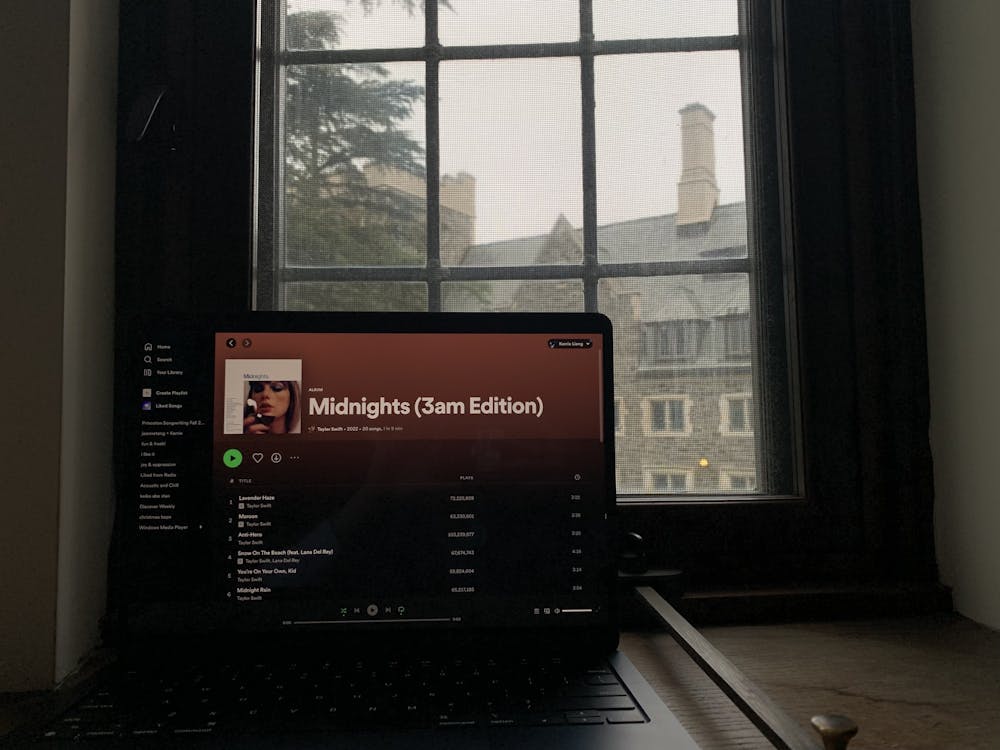On the chilly night of Oct. 20, the world gathered around their devices. It didn’t matter whether you were a devoted Spotify user, an Apple Music enthusiast, or a Tidal stan (do those even exist?) — we all watched the minutes trickle into seconds, waiting for Taylor Swift to sweep us away from our mundane lives into a whirlwind of romance and heartbreak. But, just like Cinderella, when the clock struck twelve, the night took a turn for the worse.
Admittedly, Swift’s last two albums, “Folklore” and “Evermore,” are tough acts to follow — the vivid imagery and softer instrumentals came at an isolating time when intimate comfort was very much needed. With her lyrical prowess pushed to the foreground, this was also the time when the wider audience began to truly appreciate Taylor Swift as more than a generic country-turned-pop artist.
Thus, when the singer-songwriter announced some gut-wrenching themes that inspired her latest album “Midnights” — self-loathing, wondering what could have been, falling apart — I was ready to break up with my non-existent boyfriend, open a bottle of red wine, and lament.
Perhaps it’s true that a great portion of my disappointment comes from the skyscraper expectations I had constructed. However, that is not to say that the album did not warrant the criticisms it received, the biggest being its mediocrity. To put it bluntly, some of the songs felt like a millennial’s desperate attempt to appeal to a younger generation, and — let’s be honest — that’s because they probably were.
In “Karma,” for example, Taylor Swift sprinkles Gen-Z slang throughout the chorus while simultaneously referencing her “cat mom” aesthetic. The unnerving combination of the two mix like water and oil, and ultimately seems like an uncanny attempt to seem relatable. I can’t quite figure out if this is iconic or corny, but either way I’m left feeling slightly uncomfortable.
Meanwhile, although “Vigilante Shit” tries to paint a fierce, feminine character, the track’s opening line, “Draw the cat eye / sharp enough to kill a man,” reminds me of an era I wish to forget. When listening to the album, I have a hard time believing that this is the same woman who ripped my heart out with “tolerate it” and “mirrorball.”
However, this is not to say that the album was terrible; in fact, Taylor Swift’s return to pop gifted us with more dynamic instrumentals compared to the simple guitar background in “Folklore” and “Evermore.” While the songs on “Midnights” did not explore any particularly experimental chord progressions, the production included little details that added some enjoyable “ear candy.” For instance, in the chorus of “Mastermind,” the swallowing bass creates a more menacing mood, which complemented the lower, rhythmically puncturing melody — the idea of a Machiavellian schemer really came to life here. Moreover, the distorted voices in the background of “Lavender Haze” created a clouded, slightly hallucinogenic atmosphere. Listening to the introduction, I immediately pictured muted city lights captured on slow shutter speed — if the idea of being “drunk on love” was a sound, it would be this.
To me, the real gems were hidden in the “3am Edition” of the album, which included seven bonus tracks. The highlight of the album came in the penultimate track, “Would’ve, Could’ve, Should’ve.” Just when we thought Taylor Swift was done burying her former lover John Mayer into the ground, she delivers the last fatal blow in a heart-wrenching bridge and final verse. In the outro, when the melody features the higher end of her vocal range, she sounds hauntingly similar to her 19-year-old self. As a listener, I found my heart served on a silver platter alongside John Mayer’s head. The emotional weight behind this song almost made it worth listening to the 18 songs that precede it — almost.
Besides its mediocrity, what I find most upsetting about “Midnights” has nothing to do with the album itself, but rather in the way that some Taylor Swift fans have responded to criticism of “Midnights.” Rather than engaging with the content of the feedback, some people have turned to gatekeeping and ad hominem attacks of varying severity in a desperate attempt to maintain some supposed sanctity of Swift’s reputation. Some fans, for example, argued that if you didn’t like the music, then your opinion is invalid because the music was only made for “true fans.” This is absurd — music can interpreted or enjoyed by anyone.
When an artist puts their work out into the world, they are giving up control over the narrative. As witnesses of art, we then mold their narrative to try and fit our own. Sometimes, it doesn’t quite work out, so we reject it — and that’s okay; not every puzzle piece fits every puzzle.
It’s one thing to understand that not everyone connects with a certain work of art, but it’s another to claim that there is some dichotomy of who is and isn’t “allowed” to interpret it. In doing the latter, we are constructing the artist to be some puppeteer who dictates what the “correct” interpretation is. Moreover, by limiting certain members of the audience and removing discourse, art becomes a bore. There is great value in subjectivity: through different perspectives, we come to learn a little more about both the art and ourselves. By forcing art into an echo chamber, this insight is lost.
“Midnights” is a mixed bag. While some songs made me feel like the protagonist in a tumultuous love story, others made me feel like I was talking to my “cheugy” aunt. Although this criticism can be a hard pill to swallow for some, it’s important to embrace the way that art is subject to unfiltered judgment, whether we like it or not. Taylor Swift’s art has value precisely because everyone internalizes it uniquely, and as an enjoyer of her work, you should be excited — not appalled — that it has the ability to affect people in different ways. After all, you can be a fan without being a partisan loyalist.

Kerrie Liang is a head editor for The Prospect and an assistant editor for Podcasts at the ‘Prince.’ She can be reached at kerrie.liang@princeton.edu, or on Instagram at @kerrie.liang








